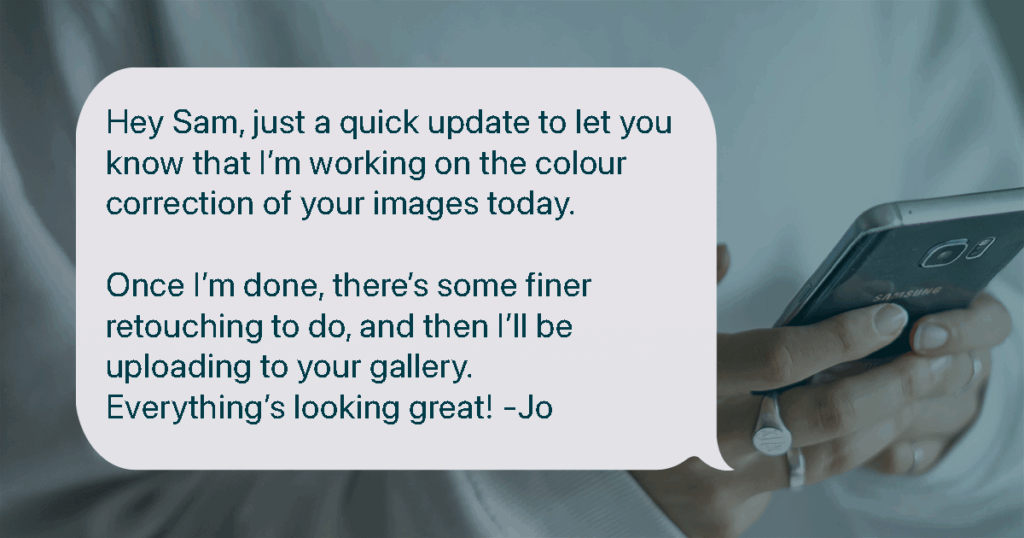How to Manage Photography Client Expectations

Your photography clients will have expectations – plenty of them. And it’s part of your job to manage them, meet them and even exceed them.
Here we’ll explore how to avoid potential client disappointment every step of the way.
Setting the Stage
Before a contract is signed, make sure your ‘expect expectations’ mindset is in full effect from the very first interaction. Every form of communication will be a chance to start gathering and assessing them.
Ask targeted questions to gather all the information you need, and be sure to clearly explain how you work and what your clients can expect. This includes things like the number of images you’ll deliver, your turnaround time, pricing for any additional products or services, and key milestones or timelines.
And it’s always wise to add a cover-all question such as ‘Are there any special accommodations I need to make on the shoot?’ For example, the bride and groom may have forgotten to mention how a precious grandparent is in a wheelchair so won’t be able to appear in shots taken in inaccessible locations.

Creating your own checklist of questions and key talking points at this early stage will offer reassurance that you can comfortably manage those expectations. However many there are…
And don’t be shy of framing these as expectations to your client. As an approach to get them thinking along the same lines, they’ll welcome your professional transparency and commitment to high standards.
Act 1: Make Those Expectations Realistic
Client expectations in place, it’s now time to resist any urge to over-promise and under-deliver. We know it’s tempting to say yes to every little request – but you need to protect your time and your headspace.
So make the contract crystal clear and watertight to share guidelines and establish boundaries. This detail isn’t just for legal protection, it’s also an expectation management must-have.
Review all the nitty gritty with your client, clarifying everything about scope, budget, timeline and deliverables, to avoid any confusion or miscommunication.
During that conversation, be honest about any potential limitations – both for their benefit and yours. This needs to be a mutually successful and enjoyable experience.
While impressing them with your skills, professionalism and friendliness, avoid overestimating your abilities or resources.

For example, if a tight event timeline means you’ll be rushing between locations, it’s worth having an honest conversation about the options – whether that’s bringing in a second photographer, adjusting the schedule, or prioritising the shots and locations that matter most to your client.
After a good chat about positive solutions to limitations and with realistic processes and outcomes in place, swerving disappointments and misunderstandings becomes more likely.
Act 2: Communicate Clearly
Central to your whole expectation-management approach is clear, open communication. Let it trickle confidently into every aspect of your business.
Actively listen to understand their vision and preferences while providing regular updates throughout the project so they know exactly what to expect and when.

Keeping in close contact throughout the process, asking for feedback/input and being responsive to queries means you can handle any potential scope creep that could jeopardise a happy outcome.
Act 3: Use a CRM for Effective Expectation Management

Your clear communication mission can be significantly streamlined by using a dedicated CRM for photographers like Light Blue.

Taking centre stage as your own personal business hub, it can help keep track of individual client preferences, schedule key communication dates and set handy reminders to keep your project on track.
All designed to eliminate miscommunication and simplify every step.
Act 4: Brace Yourself for Any Unexpected Challenges
Even when you’ve done all you can to manage expectations, life happens. Equipment can fail, the weather can misbehave, a crucial prop might break.
So build a chunk of friendly flexibility into your shoot planning so you can improvise when it’s appropriate.
And if you face the dreaded Difficult Client – even after setting expectations from the word go – get some tips here.
The Final Scene: Deliver What You’ve Promised
This one goes without saying but we’ll say it anyway: deliver the images you’ve agreed to on time and on budget. All while promptly addressing any revision requests, avoiding any unagreed add-ons and clarifying usage rights.
There are also some slightly sneaky and client-pleasing ways to subtly under-promise and over-deliver.
You can share their images early by building in a time buffer zone – you’ve promised two weeks but can actually get them done within ten days. Or you could give them an unexpected extra like a small print credit.
Alongside all the key client photography expectations, the end of the project is an opportunity to gather feedback.
And of course, one of your questions can be “Did my service meet your expectations?”
Take our advice on board and get ready to become your client’s hero by exceeding them every time.
Related
- How To Attract Your Ideal Photography Clients
- Book more clients by phoning your leads - tips for making successful calls
- Using Sales Data to Drive Smart Upselling
- How to deal with difficult clients
- The Ultimate Guide to Selling Wedding Albums: Insights from Folio Albums and How Light Blue CRM Can Boost Your Sales
- How to Find a Consistent Photography Client Base
- How to Get More Word-of-Mouth Referrals
- How to Automate Time-Consuming Tasks
- The Photographers’ Guide to Finances and Budgeting
- How to Give an Exceptional Client Experience